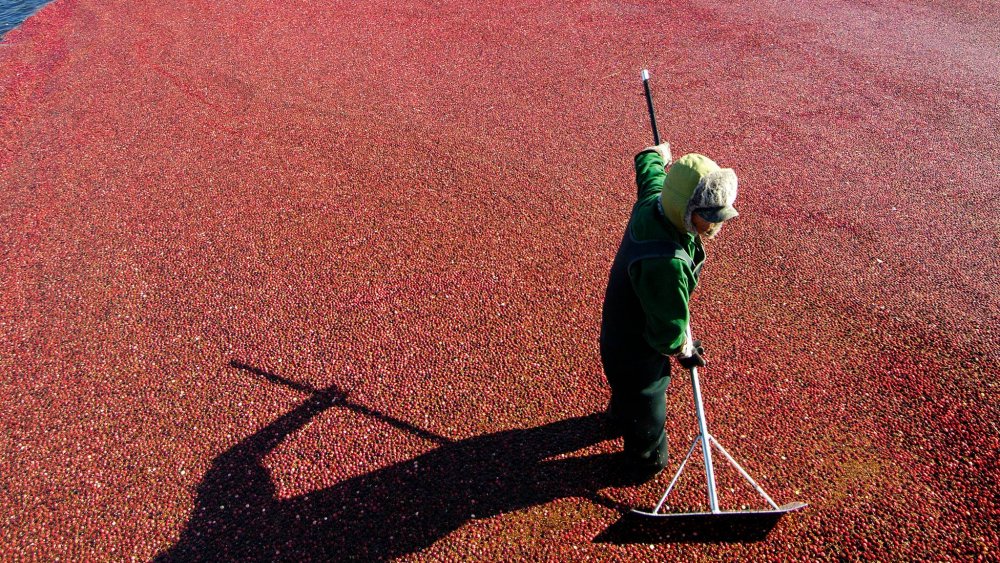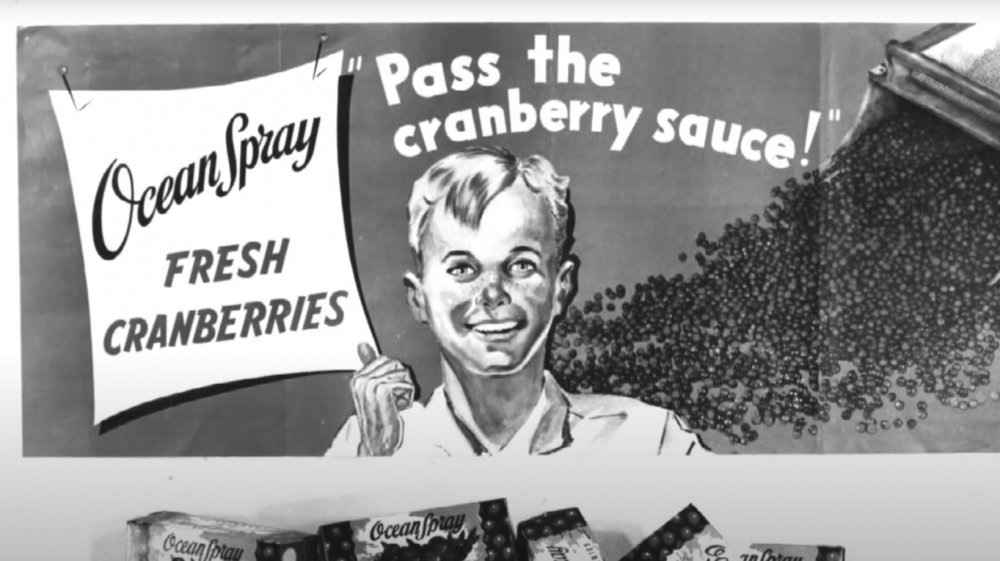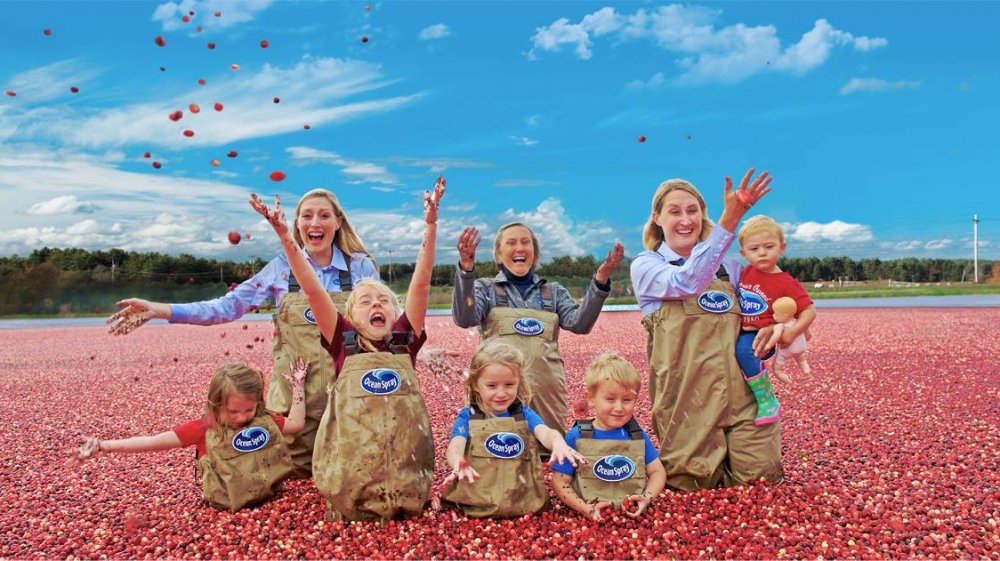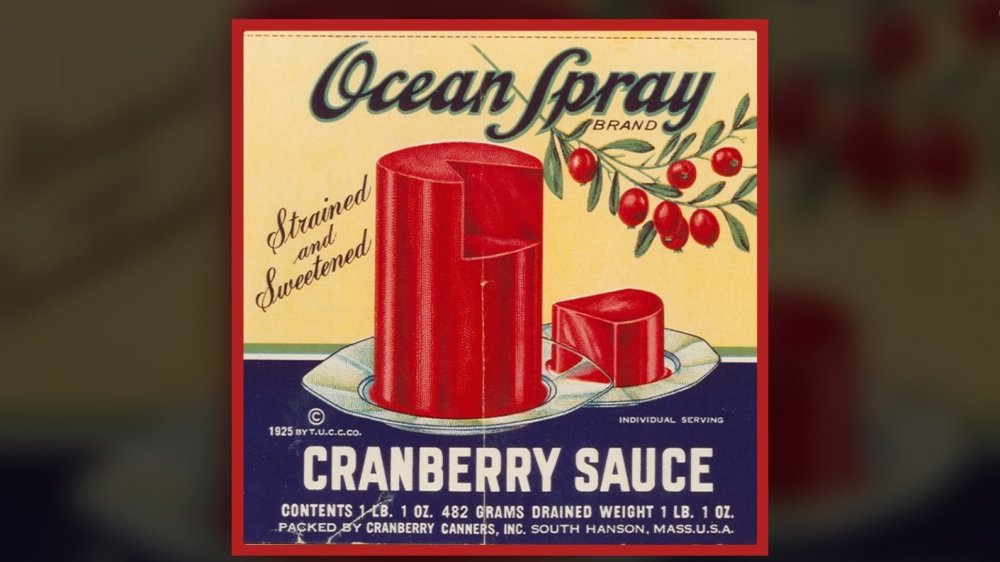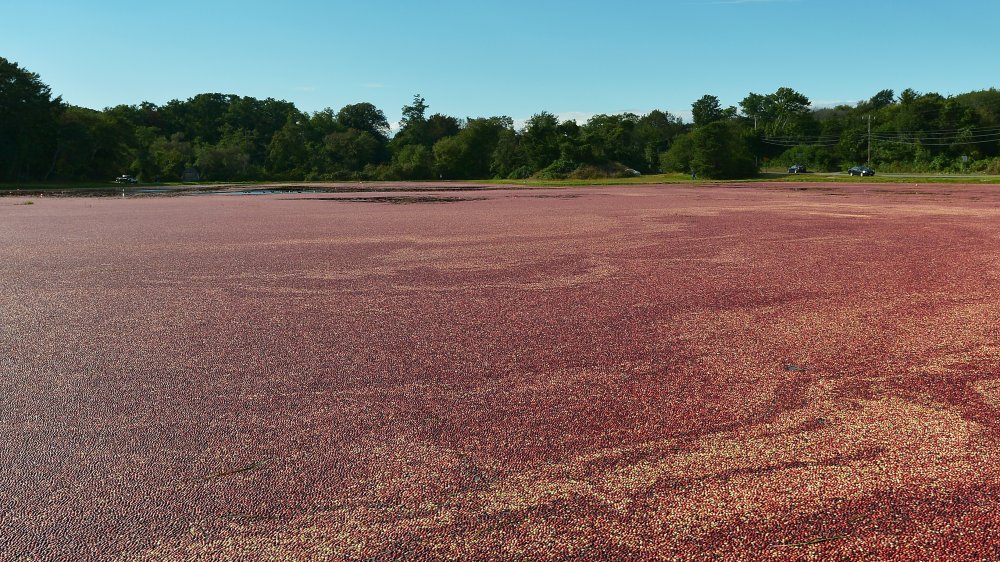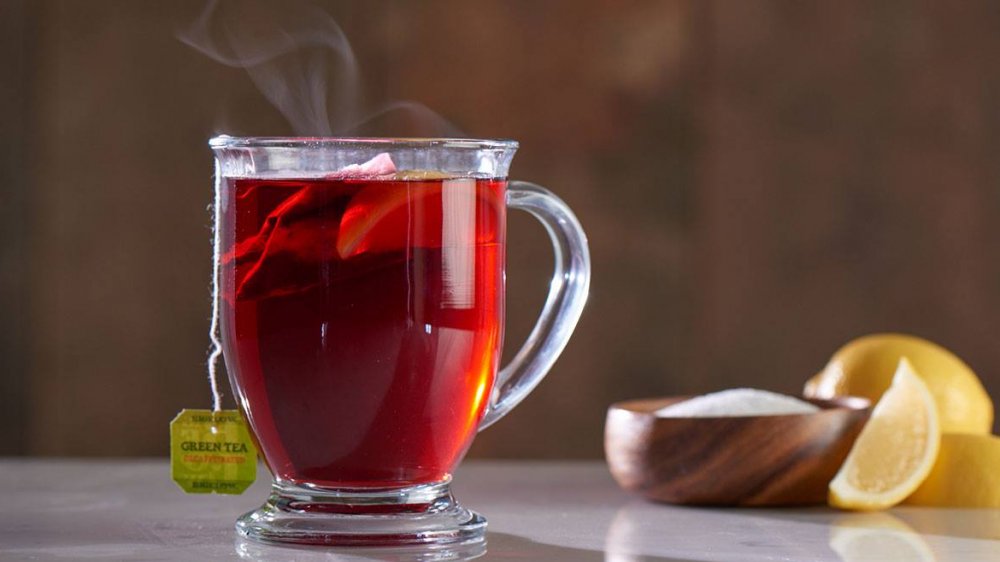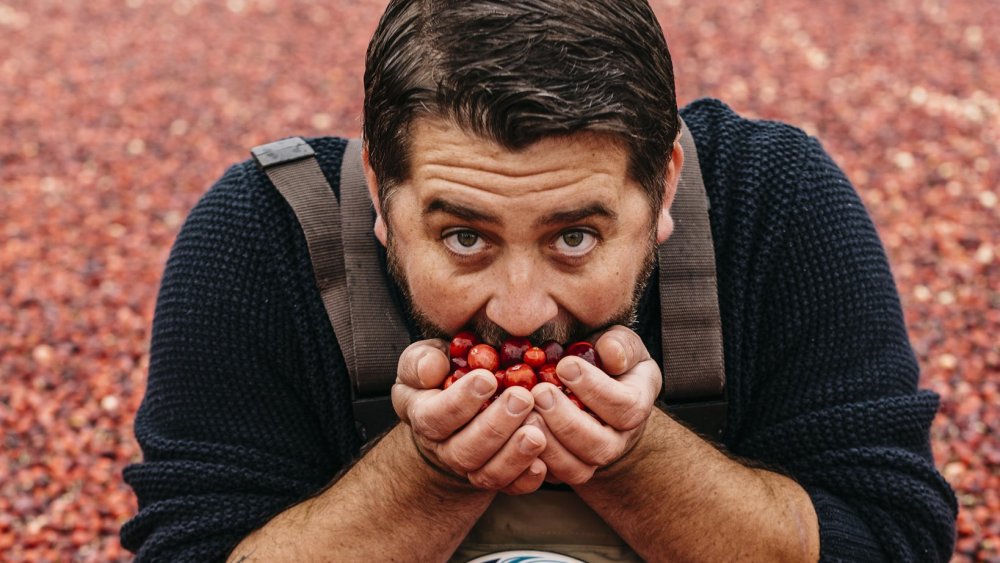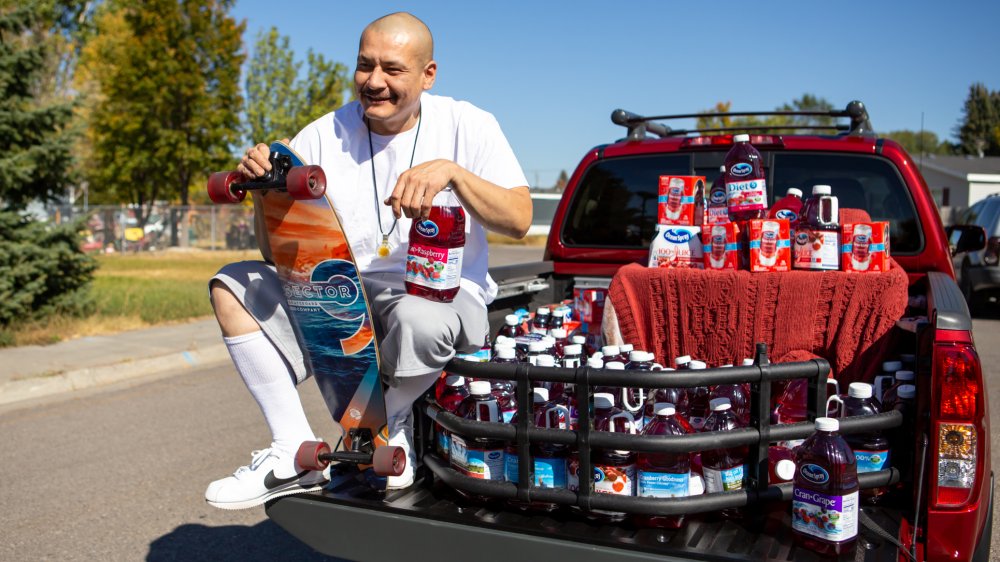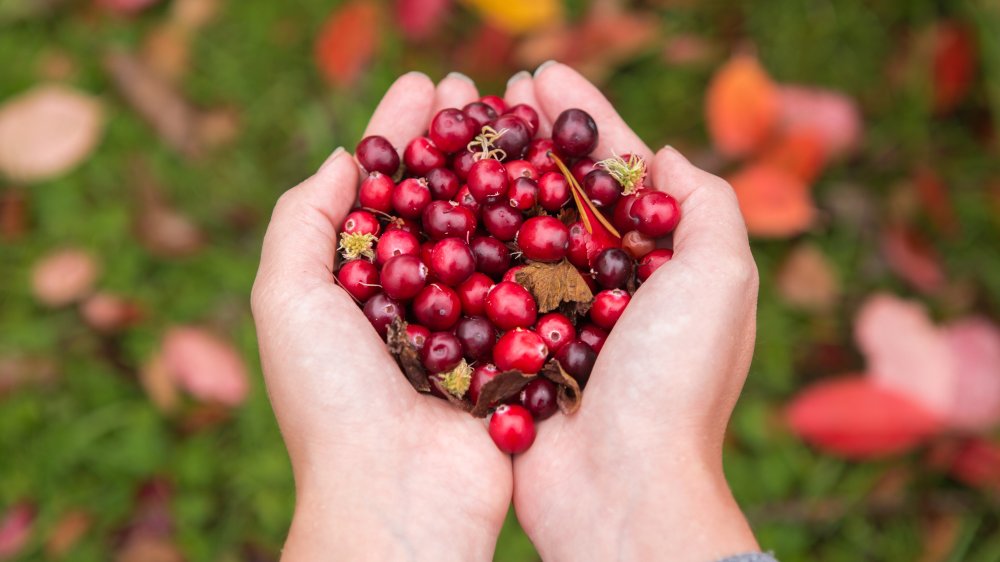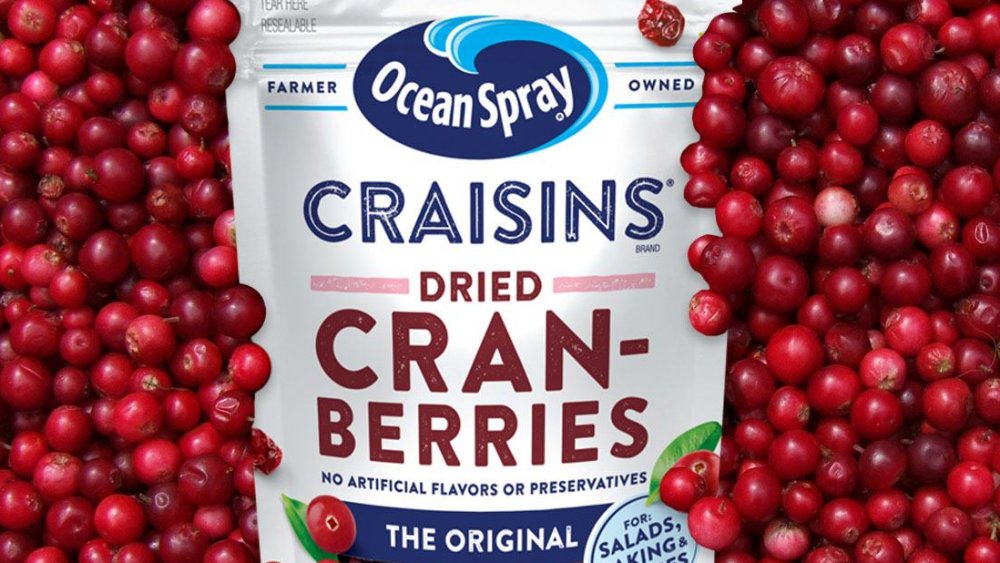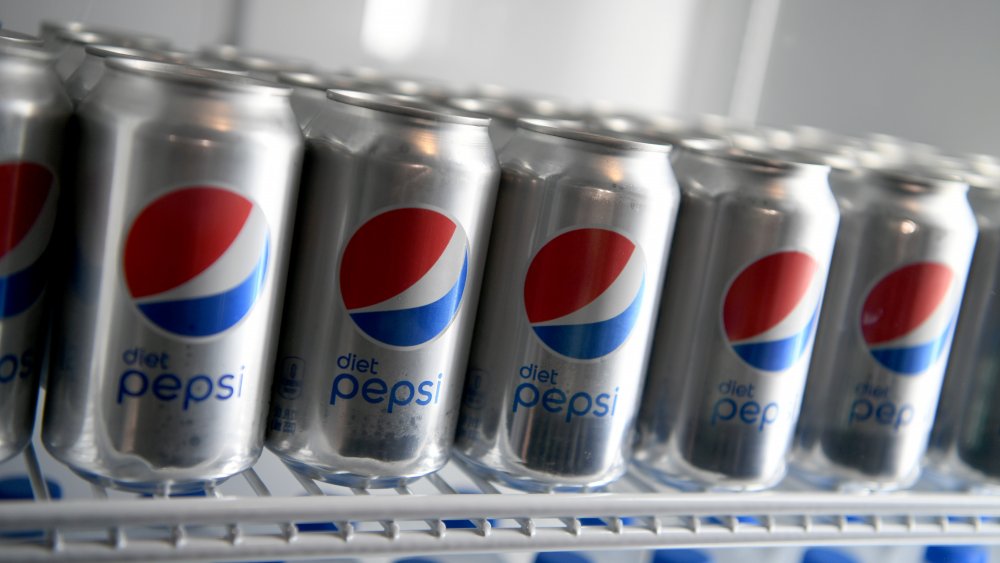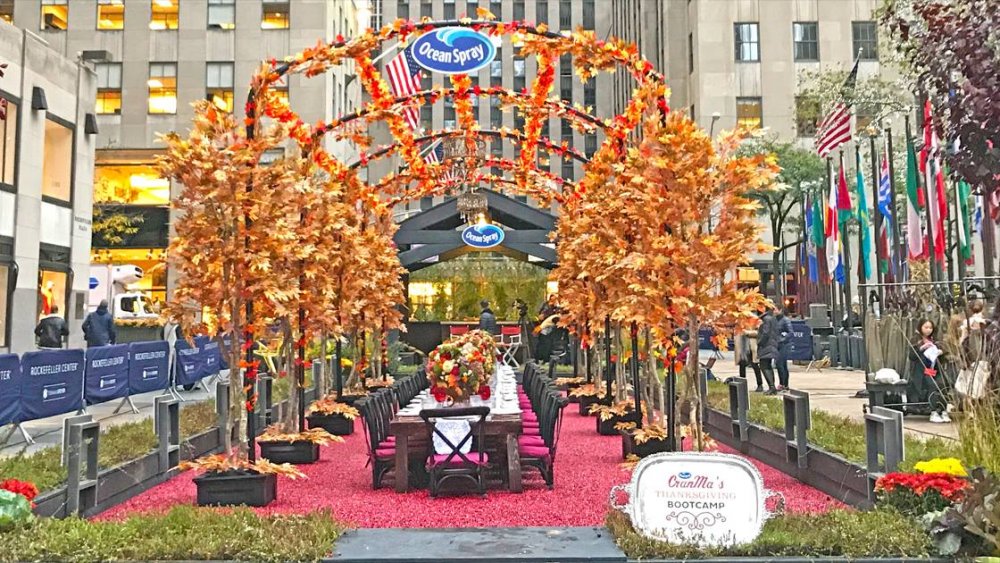The Untold Truth Of Ocean Spray
Ocean Spray, an agricultural cooperative consisting of 700 family growers, harvests 220 billion cranberries a year. With all those harvested berries they make 88 million cans of cranberry sauce and 223 million bottles of juice (via Business Insider). If that seems like a lot, know this: Americans consume 400 million pounds of cranberries each year. The cranberry consumption peaks during the holiday season. As an ode to their popular jellied cranberry sauce, 5 million gallons of which are consumed by Americans every holiday season, they unveiled the world's largest can of Cran (the sauce) in 2018, in Times Square. It weighed 500 pounds.
Headquartered in Lakeville-Middleboro, Massachusetts, Ocean Spray's products are sold in 100 different countries (via Business Insider). If you roll down their social media pages, all you see are pictures of happy farmers, cranberry cocktails, and numerous bogs with floating cranberries. However, the cooperative has had its ups and downs. In the early 2000s, the cranberry prices had hit rock bottom because of the large stock of cranberries that did not see enough demand. Out of this challenge rose Craisins, dried cranberries – a revolutionary product that saved the cooperative (via Boston Magazine).
Innovation is at the center of Ocean Spray's growth. They've been constantly pushing the boundaries with products like cranberry-tea blend, cranberry-Colombian coffee blend, cranberry water etc. Here are the little known truths about the 90-year-old cooperative.
Three independent farmers started Ocean Spray in 1930
Despite the fact that cranberries are harvested only between mid-September and mid-November in North America, it is not hard to buy a can of jellied cranberry sauce or dried cranberries in the peak of summer. Thanks to the advancement in science and to a certain gentleman called Marcus L. Urann.
About a century ago, cranberries were strictly a Thanksgiving food. But Urann, a lawyer by profession, decided to work towards something that many desired: make them available all through the year. He became a full-time cranberry grower, bought a bog in Massachusetts, set up cooking facilities, and came up with the first canned cranberry sauce (via Smithsonian Magazine).
Urann was not just an innovator, he knew to manage his business well. As a way to protect farmers from the uncertainties regarding the crop's volume and price each year, he convinced other independent cranberry growers such as John C. Makepeace from Washington and Elizabeth F. Lee from New Jersey to join him and form a cooperative so that they can share the profits and help each other. Thus was born Ocean Spray — though it was called Cranberry Canners Inc at the time. Later, it changed to National Cranberry Association. It was only in 1957 that it got its current name, which according to Smithsonian, was the name of a Washington state fish company. Urann bought the rights to the name and the logo from the company.
More than half of Ocean Spray farms are owned by women
Ocean Spray cooperative is made up of over 700 grower families in the United States, Canada and Chile. All growers own and manage their own farms — the average size of each farm being 18 acres. More than half of these farms, according to a tweet by Ocean Spray, are owned by women. Some examples include the 78-year-old Gottschalk Cranberry Inc. farm in Wisconsin that is owned by Fawn Gottschalk who operates it with her parents, and the Gilmore Cranberry Company, established in 1979. It's owned by Sue Gilmore, who is also a descendent of one of the founding families of Ocean Spray — the A.D. Makepeace family. Gilmore's grandchildren are seventh-generation cranberry farmers!
According to their website, "25 percent of our farmers are fourth generation or greater." Having said that, there are also a few first-generation farm owners, such as Iain Ward from Massachusetts who quit his job of writing conservation farm plans for cranberry growers to become a cranberry grower himself, or Malcolm and Ardell McPhail who gave up their jobs as Washington State University Extension Agents, to manage their farm in Washington (via Ocean Spray).
Ocean Spray's first products were cranberry sauce and cranberry juice cocktail
One would imagine that a cooperative which is formed by cranberry growers would have first launched fresh cranberries as their main product. Apparently not. It took them 16 years to introduce fresh cranberries as one of the products that they sold. Their first product was canned cranberry sauce, which to this day remains a popular Thanksgiving side dish.
A year after their launch, in 1931, they gauged a growing interest in orange juice among people. So they entered the beverage market with Cranberry Juice Cocktail. According to a report, it was marketed as "a pleasant, smooth drink with delicious flavor and sure relief from faintness, exhaustion and thirst. A glass when retiring promotes sleep and a clean mouth in the morning — even to the smoker." Soon after, came Ocean Spray Cran, which was meant to be added to alcoholic beverages.
Till the 60s, Ocean Spray's most popular selling products remained their sauce and fresh berries. The juice cocktail saw only limited distribution, which is why they put their creative caps back on, and came up with the first juice blend in the world — cranberry apple juice, or CRANAPPLE, as Ocean Spray titled it. What followed was another hit combination, cranberry and grape, or Cran-Grape. Another three decades would pass, before Craisins (dried cranberries) were introduced as a baking ingredient in the 1980s.
Ocean Spray's existence was threatened by the Cranberry Scare of 1959
Ocean Spray had been launched for close to three decades before the Cranberry Scare of 1959 threatened to end its existence. A few months before Thanksgiving that year, the U.S. Department of Health, Education and Welfare (HEW), announced that a certain weed killer called aminotriazole was responsible for causing cancer in lab animals. This weed killer or herbicide was used by a few cranberry growers. And though Ocean Spray was quick to respond, and ban the use of the herbicide, the fear had spread among consumers, who, that year, decided to keep away from the cranberries. Sales plummeted to record low, especially in the holiday season when they would otherwise be at their peak (via Ocean Spray).
What's unfortunate is that the scare was avoidable. What HEW missed to point out was a person would need to eat 15,000 pounds of cranberries every day for years to get cancer. The main culprit behind the confusion was the Delaney Clause, which banned all artificial substances that caused cancer in lab animals from a food product. Unfortunately, it had failed to consider the differences in metabolism, digestive system, and immune system between rats and humans. The trace amounts of herbicides do not affect humans the same way as they would rats. Therefore, in 1996, herbicides and pesticides were removed from the Delaney Clause (via Forbes). But by then, enough damage had been done, and Orange Spray struggled to bounce back.
Ocean Spray offers health-focused drinks
Ocean Spray has been championing the cause of health since the 1980s, when they collaborated with the Women's Sports Foundation to spread awareness about adopting healthy lifestyles. In 1994, what helped Ocean Spray brand their product as good for health was a Harvard Medical Research study that showed that cranberries help keep Urinary Tract Infections at bay. The cooperative used this study to fuel their initiative Cran-Health, as part of which they sold low-calorie juice drinks with sucralose (contains no calories) instead of sugar (via Ocean Spray). Cranberries, which are packed with vitamins, minerals, fiber, and antioxidants, had risen to superfood status. And Ocean Spray milked this new glory by introducing a line of beverages that focused on health.
In 2008, they launched Cran-Energy — a drink that combined real fruit juices mixed with green tea. Less than a decade later, they came up with PACt Cranberry Extract water, which used the nutritional extracts from cranberries (proanthocyanidins) that when consumed help flush out certain harmful bacteria from the body. Soon after, they introduced Cranberry +Health (not to be confused with Cran-Health), which has the "highest concentration of cranberry compounds available among Ocean Spray juice products," according to a report on Ocean Spray's website. The report quotes a study published in the American Journal of Clinical Nutrition that says, "drinking one 8-ounce glass of cranberry juice per day can lower the number of recurrent symptomatic UTIs in women."
Ocean Spray connects farmers with chefs
Ocean Spray has always been on the lookout for new chefs and foodservice professionals who are keen to adopt the humble berry into their everyday meals. As a step towards this pursuit, the cooperative had launched the Ultimate Cranberry Recipe contest, out of which came award-winning dishes such as Kickin' Chicken Tortilla Soup with Zesty Cranberry Crème Fraîche by Shonna Ebert of Dietert Center in Kerrville, Texas, and Cranberry Mojito by Jeff Leidy of Centerplate in San Diego, CA.
Taking it a step further, in November 2019, Ocean Spray launched an initiative called Cranberry Chef Collective that aims to connect chefs with 700-plus farmer families that are part of the Ocean Spray cooperative. The initiative was formed with the vision of exposing top chefs to the workings of a cranberry farm, letting them know the fruit intimately, and having them use the tart berries in their restaurant menus. Who wouldn't be curious about a cranberry-apple cobbler pie on their dessert menu? The dish, created by Chef Will Gilson of Puritan and Company, in Cambridge, Massachusetts, uses cranberries for its filling.
Gilson is one of five chefs who are part of the Collective. The other names include Irene Li of Mei Mei in Boston, Cassie Piuma of Sarma in Somerville, Massachusetts; Liam Lutrell Rowland of Spindler's in Provincetown, Massachusetts; and Evan Mallet of Black Trumpet in Portsmouth, New Hampshire.
A TikTok video got Ocean Spray's name trending on social media
Thanks to Nathan Apodaca, a warehouse worker from Idaho, Ocean Spray found its name trending on Social Media. On September 25, 2020, Apodaca (who goes by the moniker 420doggface208 on TikTok) posted a video of himself longboarding to work after his 2005 Dodge Durango broke down on the middle of the road. He had little clue that the short TikTok video where he is seen sipping Ocean Spray's cran-raspberry juice, and lip-syncing the 70s hit "Dreams" by Fleetwood Mac, would go viral.
The video, which garnered over 60 million views on TikTok, changed Apodaca's life forever. Now, he is a social media celebrity with an agent. The impact, however, went beyond him. The Fleetwood Mac song, which released back in 1977, climbed back to Billboard's top 100 list. And Ocean Spray got a sweet publicity boost.
Ocean Spray's chief executive Tom Hayes told Yahoo Finance: "We have about 15 billion media impressions now." What this means is that in just a couple of weeks after the video's release, Ocean Spray's name had been searched 15 billion times. "Retailers say there is an additional draw off the shelf, particularly with cran-raspberry," said Hayes. While still basking on the video's popularity, the cooperative gave Apodaca a new Nissan pick-up truck and had Hayes take up the #doggfacechallenge where he emulated Apodaca on his skateboard, while taking generous sips of the Ocean Spray juice.
Ocean Spray's cranberries are sustainably grown
Ocean Spray's cranberries are 100 percent sustainably grown, according to the Sustainable Agriculture Initiative Platform's Farm Sustainability Assessment. What this means is that the farmers who are part of the Ocean Spray team grow their cranberries in a way that "protects and improves the natural environment, the social and economic conditions of farmers and their communities, and safeguards the health and welfare of all farmed species," according to a report.
A large amount of water is used to harvest the cranberries, as it's much easier to get the cranberries off their vines when they are floating on the surface. All the water, however, is reused in other parts of the farms as soon as the harvesting is done. In order to limit the amount of water that is sourced out of a natural water system, farmers share the same water between their farms. They use soil moisture probes to ensure that they don't use more water than they need. Not just that, "For every 1 acre of growing cranberries, Ocean Spray farmers manage an average of 5.4 acres of supporting lands and wetlands," according to the website.
Moreover, the cooperative is also working with National Geographic to encourage regenerative farming practices — which involves reversing "climate change by rebuilding soil organic matter and restoring degraded soil biodiversity — resulting in both carbon drawdown and improving the water cycle," according to Regeneration International.
Ocean Spray products use recycled packaging
Besides practicing sustainable agriculture, Ocean Spray also thought about the lifecycle of the packages in which it sells its products. For example, acknowledging the fact that the plastic bags in which they sell Craisins can have a negative impact on the environment, they have taken steps to keep their conscience clear. The cooperative has partnered with a waste management company called TerraCycle, which can make sure that you buy multiple bags of Craisins without a trace of guilt.
The partnership between the two companies allows Ocean Spray customers to send their empty Craisin bags to TerraCycle, in exchange for points that can be used towards helping out a non-profit organization or school. The plastic bags will be melted and remolded to make new products such as park benches or picnic tables, according to TerraCycle website.
Ocean Spray is also working with TerraCycle to develop reusable packaging through its Loop platform. Under this platform, customers get to buy Ocean Spray's products in reusable packaging, and then return the empty packages when done. The packages will be cleaned, sanitized, and refilled with the original products for reuse.
Ocean Spray and PepsiCo share a bittersweet relationship
Back in the '90s, PepsiCo used to distribute Ocean Spray beverages to convenience stores. Everything was going fine for both the companies, until Pepsi, in its effort to expand, bought Ocean Spray's competitor Tropicana in 1998. As soon as the news came out, Ocean Spray sued PepsiCo for violating their distribution contract, as now they would have to distribute their competitor's products too (via The New York Times). The lawsuit was dropped around 2000, and all bitterness was buried.
After acquiring Quaker Oats Company in 2001, PepsiCo was eyeing Ocean Spray in 2004. PepsiCo wanted to acquire half of the top cranberry juice seller's business. However, when the decision was put to a vote among the farmer-owners of Ocean Spray, about 52 percent voted no, according to a report by The Associated Press (via The New York Times).
Though Ocean Spray rejected PepsiCo acquiring any part of it, they were open to forming alliances for the benefit of their products. In 2006, Ocean Spray gave PepsiCo the right to "market, bottle and distribute single-serve 15.2 ounce bottles of cranberry juice products in the U.S. and Canada under the Ocean Spray name." Three years later, PepsiCo could do the same for five more Ocean Spray products including Ruby red grapefruit juice and Pineapple peach mango juice among others.
Ocean Spray launched gummies for sun protection
In October 2019, Ocean Spray launched an innovation incubator program called Lighthouse, with the aim of creating an entrepreneurial attitude inside the company. Within a year of its launch, the initiative gave birth to five new brands. The first to launch was Atoka — a line of wellness drinks that include "Tea Tonics, Oatmilk Elixirs and Herbal Shots" (via PR Newswire). Some of the blends include a mix of cranberry, guayusa, ginseng and ginger, and yet another, which is a mix of cranberry, linden flower, lemongrass, orange peel and ginger mix, among others.
Besides Atoka, the incubator program has been successful in thinking of "out-of-bog" ideas when it comes to using the nutritional value of cranberries other than in juice and sauce. So they came up with a cranberry-based gummy under a new brand called Dabbly. These gummies are meant to act like sunscreens, except you simply pop one into your mouth. Rizal Hamdallah, Ocean Spray's Chief Growth Officer, said in the Food for Thought podcast that with the new product they expect to "disrupt sun care or sun protection market" which is now dominated by lotions or creams that you put on your skin.
The team at Lighthouse also stormed up the idea of a CBD beverage that goes by the brand name CarryOn, and Tally-Ho — another brand that focuses on the oral and emotional health of your pet.
Ocean Spray has set up pop-up cranberry bogs in cities
Cranberry bogs make for some unique Instagram-worthy shots. Imagine standing amidst a shiny red bed of cranberries. The only challenge: finding a bog near you. Cranberries grow only in select climatic conditions, and in select U.S. states such as Massachusetts, Wisconsin, New Jersey, Oregon, and Washington. To expose the superfood to more people, Ocean Spray, as part of its promotional activity, set up mini cranberry bogs in the middle of busy cities to get city dwellers more curious about the tart berry. In 2017, the pop-up bog at Rockefeller center had popular chef Curtis Stone dine with Ocean Spray's growers. The same year, the cooperative set up a bog in Boston to celebrate the last harvest of the year, at a Food and Nutrition Conference in Chicago, and at the National Mall in D.C.
The pop-up bogs had growers demonstrate the process of harvesting cranberries which is quite unlike the harvesting process for any other crop. Once the berries are ripe, the farmers flood the bogs with water to make the cranberries float before using special equipment to remove all the ripe berries from the vines. This is done by just dragging the equipment along the bed of cranberries (via The New York Times). This method is more convenient compared to the time-consuming alternative that involves farmers plucking each and every cranberry from the vine.
